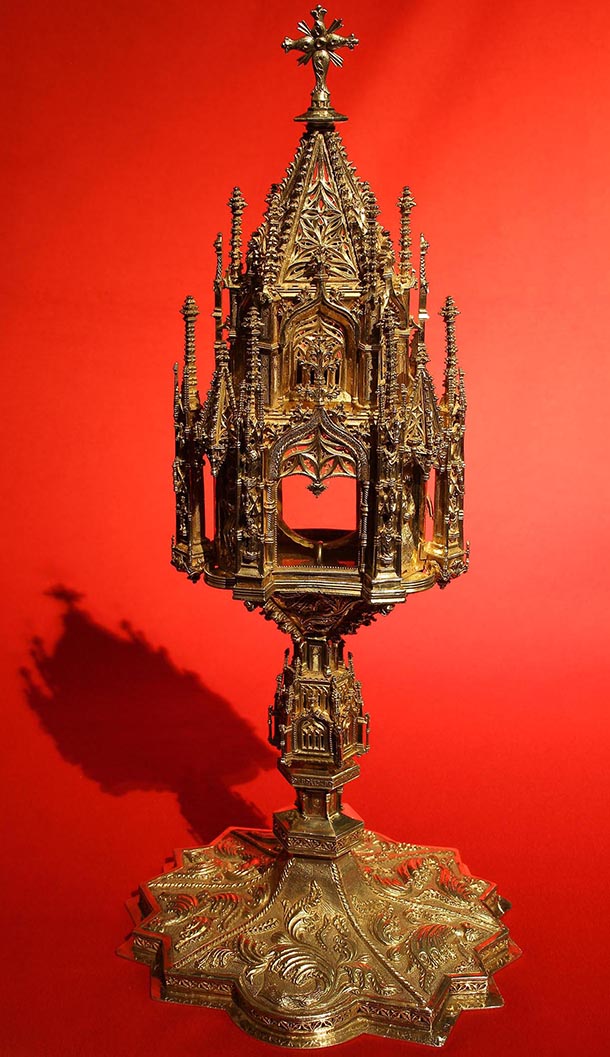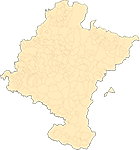Parish Church of San Pedro de Aibar
Custody
Among the pieces that make up the liturgical trousseau of this parish church, one of the most outstanding places is occupied by this monstrance. Made of gilded silver and dated around 1476-1488, it was probably made in Burgos by the silversmith Juan de Santa Cruz. The piece bears the Burgos mark among its three marks, and the characteristics of this piece are from agreement with a model that was very popular and widespread in the Castilian-Leonese area, as evidenced by the numerous examples preserved in parish churches and temples in Castile. In this particular case, it is possible that we are dealing with the oldest preserved type of portable monstrance from a Burgos shrine. A commission or a donation would explain its arrival at San Pedro de Aibar.
The monstrance has a mixtilinear polygonal base with alternating star-shaped points and circular lobes. As is the case with many pieces of Gothic goldsmith's work, this monstrance has a marked architectural character. In the complex composition of the shaft, the knot is highlighted by a small hexagonal temple with ogee arches, buttresses and pinnacles. The upper part, intended to house the Sacred Form, is divided into two sections covered by an openwork spire. The lower section is decorated with an ogee arch with balusters between niches with openwork spires, buttresses with pinnacles and flying buttresses. This first section contains angels with attributes of the Passion, apostles and other saints. The upper section is decorated with ogee arches with tracery.
ARAGONÉS, E., "El románico de Sangüesa", El Arte en Navarra, volume 1, Pamplona, Diario de Navarra, 1994, pp. 65-80.
FERNÁNDEZ GRACIA, R., ANDUEZA UNANUA, P., AZANZA LÓPEZ, J. and GARCÍA GAINZA, M.C., El arte del Barroco en Navarra, Pamplona, Gobierno de Navarra, 2014.
FERNÁNDEZ GRACIA, R., ECHEVERRÍA GOÑI, P.L. and GARCÍA GAINZA, M.C., El arte del renacimiento en Navarra, Pamplona, Gobierno de Navarra, 2005.
FERNÁNDEZ-LADREDA, C., MARTÍNEZ DE AGUIRRE, J. and MARTÍNEZ ÁLAVA, C.J., El arte románico en Navarra, Pamplona, Gobierno de Navarra, 2004.
FERNÁNDEZ-LADREDA, C., MARTÍNEZ ÁLAVA, C.J., MARTÍNEZ DE AGUIRRE, J. and LACARRA DUCAY, M.C., El Arte Gótico en Navarra, Pamplona, Gobierno de Navarra, 2015.
GARCÍA GAINZA, M.C. and ORVE SIVATTE, M., Catalog Monumental de Navarra. Merindad de Sangüesa, volume IV*, Pamplona, Government of Navarra, 1989.
GARCÍA GAINZA, M.C., La Escultura Romanista en Navarra, Pamplona, Government of Navarre, 1986.
HEREDIA MORENO, M.C., ORVE SIVATTE, M. and ORVE SIVATTE, A., Arte hispanoamericano en Navarra. Silver, painting and sculpture. Pamplona, Government of Navarre, 1992.
IZIZ ELARRE, R., Aibar-Oibar. Historia, volume 1, Tafalla, Altaffaylla Kultur Taldea, 2008.
LARRIÓN, J.L., "Romerías", Temas de Cultura Popular, number 42, Pamplona, Diputación Foral de Navarra, 1969.
LEOJENDIO, L.M., "pathway del Románico", Temas de Cultura Popular, number 85, Pamplona, Diputación Foral de Navarra, 1975.
SAGASETA, A. and TABERNA, L. Órganos de Navarra, Pamplona, Government of Navarre, 1985.












